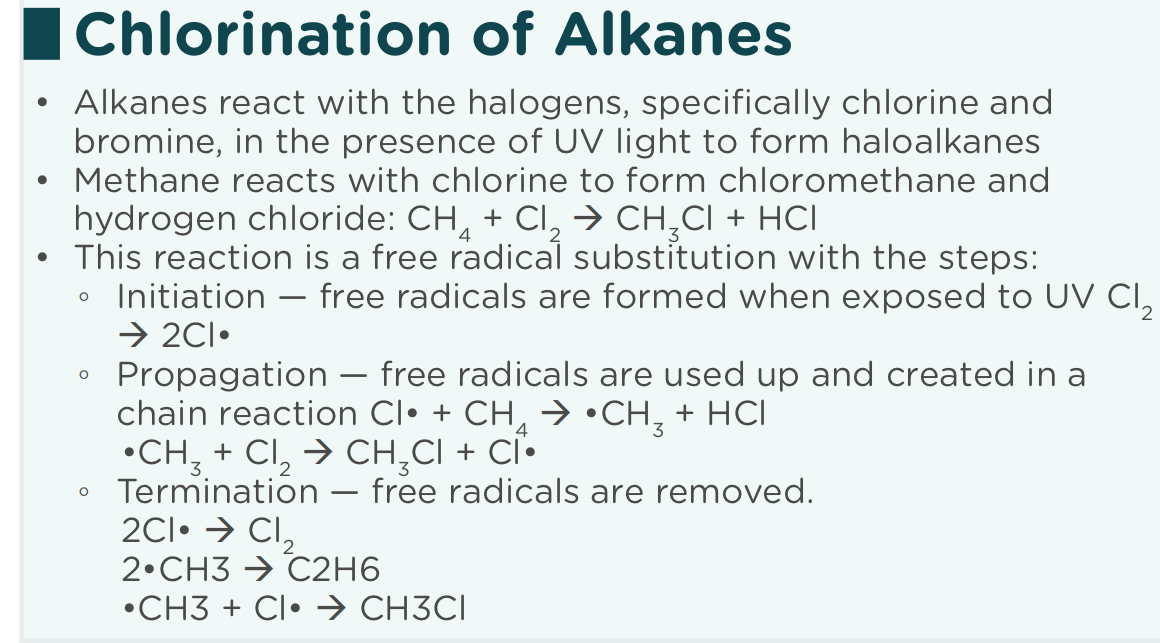organix
1/23
There's no tags or description
Looks like no tags are added yet.
Name | Mastery | Learn | Test | Matching | Spaced |
|---|
No study sessions yet.
24 Terms
Hydrocarbons - made only of hydrogen and carbon
Aliphatic - carbons atoms form a straight or branched chains
Alicylic - carbon atoms form a ring
aromatic - carbon atoms form a ring and have delocalised electron system
Homologous series
Compounds with same functional group and similar chemical and physical properties. They differ by number of repeating units they contain. Same general formula
Functional group
Group of atoms in a molecule responsible for characteristic reactions of that compound
Homolytic fission
When bond breaks, each electron in bond goes to a different atom
Forms
highly reactive free radicals
Each with an unpaired electron represented by a dot
Heterolytic fission
When bond breaks both electrons go in the same atom
forms a (+) cation and (-)anion
When are bonds formed
On the collision of two free radicals with unpaired electrons
on the collision of opposite charged ions
Isomers
Molecules that have same molecular formula but a different arrangement of atoms
Structural isomers
Same molecular formula different structural formula
1) chain
2) positional
3) functional
aldehydes and ketones
Carboxylic and esters
Alkenes and cycloalkanes
Stereoisomerism
Same structural and molecular formula but different arrangement of atoms in space
E/Z isomerism
Arises in alkenes due to restricted oration around C=C bond.
Carbon must have 2 different substituent attached
Cahn Ingold prelog rules
substituent assigned priorities based on atomic mass
2 high priorities on same side - Z
High priorities on different side - E
Alkanes
saturated hydrocarbons
CnH2n+2
Non polar - similar electronegativities between hydrogen and carbon.
Don’t react with polar reagents don’t attract nucleophiles and electrophiles
Factors affecting boiling points of Alkanes
1) chain length (molecular size) - increases B.P
there’s a greater surface area and number of electrons for strong VDW forces
2) Branching - lowers B.P
smaller surface area for contact between molecules
Weaker VDW
Crude oil
mixtures of hydrocarbons
Fossil fuel formed from breakdown of plant and animal remains that have been subject to high pressure over millions of years.
Fraction
Group of hydrocarbons with similar boiling points
Fractional distillation
Crude oil is heated
Vapour enters fractionating column
Column has temperature gradient ( hot at bottom , cooler at top)
As chain length increases BP increases due to VDW forces needing more energy to overcome forces
Components condense at different heights depending on BP
Shorter chains condense at top, longer at bottom
Cracking
Converts longer chain hydrocarbons to more economically valuable shorter chain hydrocarbons
1) thermal cracking
high temp ( 1000) and pressure (70)
C-C breaks homolytically
Forms atleast one alkane and lot of Alkanes
2) catalytic cracking
low pressure and temp (450)
zeolite catalyst ( silicon and aluminium oxide)
Forms motor fuels ( branched and cycloalkanes) aromatic compounds
Fractions and their uses in order
Refinery gas - bottled gas
Gasoline - fuel for cars
Kerosene - aircraft fuel
diesel - fuel for cars, Lorries, buses
Fuel oil - ships , power stations
Bitumen - roads , roofs
Combustion of alkanes
Incomplete = carbon monoxide , water , carbon , unburned hydrocarbons
alkane burns with a dirty yellow flame
complete - blue flame
Pollutants due to burning hydrocarbons
Carbon dioxide - green house gas
Water vapour - green house gas
Carbon monoxide - toxic , odourless gas. Absorbed by blood reduces ability to carry oxygen.
Carbon - particles causes difficulty breathing , cancer
Oxides of nitrogen - photochemical smog and acid rain
Sulphur dioxide - acid rain
Catalytic converter of nitrogen
1) removal of carbon monoxide and nitrogen monoxide
2NO +2CO = N2 + 2CO2
2) oxidation of unburnt hydrocarbons
Flue gas desulphurisation
Calcium oxide / calcium carbonate and oxyge reacts with sulfur dioxide
Oxides to make calcium sulphate/gypsum
Free Radical Substitution of Alkanes
Termination - 2 radicals make one molecule with no radicals.
fluorine - least reactive / strongest bond electronegativity decreases so polarity of bond decreases

Ozone formation